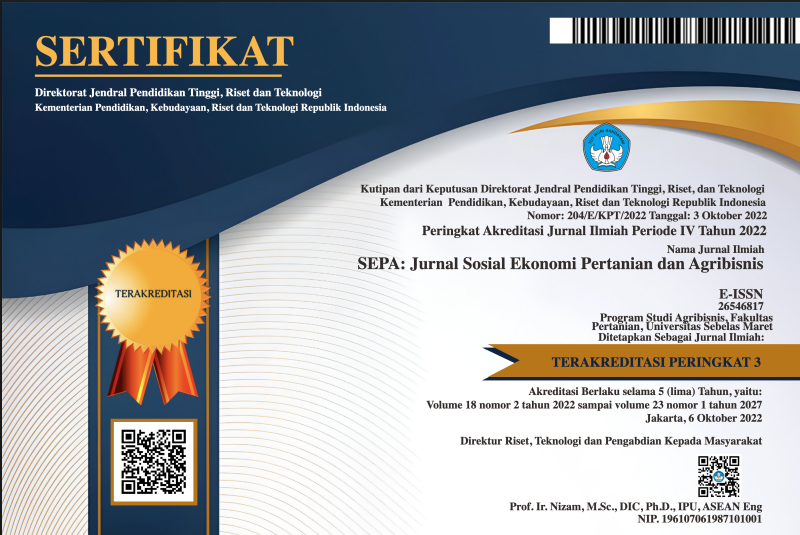TINGKAT ADOPSI PENGGUNAAN PUPUK HAYATI PADA BUDIDAYA PADI SAWAH (Oryza sativa L.) DI KECAMATAN BUNGURSARI KOTA TASIKMALAYA
Abstract
In lowland rice cultivation, farmers use chemical fertilizers without paying attention to the impact. If chemical fertilizers are not balanced with biological fertilizers, the organic content at paddy fields will decrease. This study aims to analyze the level of adoption, the factors that influence the adoption, and the strategies to increase the adoption of using biological fertilizers. This research was held in the Villages of Sukajaya, Sukamulya, and Sukarindik, Bungursari district, Tasikmalaya City, from April to June 2021. The research samples consisted of 71 farmers who were members of farmer groups. The samples were determined by using slovin’s formula. The variables of this study consist of internal factors, external factors, characteristics of innovation, and the level of adoption. Primary data was collected in the questionnaire form. The data was processed using descriptive analysis, multiple linear regression analysis, and SWOT analysis. The results of the study regarding the level of adoption of the use of biological fertilizers were in the medium category with a percentage of 49.3%. Factors that influence the level of adoption of biological fertilizers were formal education with a value of 0.026 <0.05, the relative advantage with a value of 0.001 <0.05, and the complexity with a value of 0.001 <0.05. The strategy to increase adoption using the SO strategy by maximizing to take advantage of farmer groups’ opportunities. For example, maximizing guidance to farmers through outreach activities to increase the use of biofertilizers and demonstrations on how to make biofertilizers.
Keywords
Full Text:
PDFReferences
Amala, T. A., Chalil, D., & Sihombing, L. (2014). Faktor-faktor yang berhubungan dengan tingkat adopsi petani terhadap sistem pertanian padi organik (Studi Kasus: Desa Lubuk Bayas, Kecamatan Perbaungan, Kabupaten Serdang Bedagai). Journal of Agriculture and Agribusiness Socioeconomics, 2(11), 1–12.
Badan Pusat Statistik. (2021). Hasil sensus penduduk 2020 di Provinsi Jawa Barat. Berita Resmi Statistik, 23(06), 1–12.
Hidayatullah, I. T. (2014). Pengaruh kombinasi pupuk hayati cair dengan pupuk npk terhadap populasi azotobacter sp., bakteri pelarut fosfat dan hasil tanaman caisim (Brassica juncea, l.) pada inceptisols [Thesis]. Unpad, Bandung.
Muchtar, K., Purnaningsih, N., & Susanto, D. (2014). Komunikasi partisipatif pada sekolah lapangan pengelolaan tanaman terpadu (SL-PTT). Jurnal Komunikasi Pembangunan, 12(2), 1–14.
Noer, S. D., Zakaria, W. A., & Murniati, K. (2018). Analysis of production efficiency of upland rice farming in Sidomulyo Subdistrict South Lampung Regency. Jurnal Ilmu-Ilmu Agribisnis, 6(1), 17–24.
Novita, S., Denmar, D., & Suratno, T. (2016). Hubungan karakteristik sosial ekonomi petani dengan tingkat penerapan teknologi usahatani padi sawah lahan rawa lebak di Kecamatan Sekernan Kabupaten Muaro Jambi. Jurnal Sosio Ekonomika Bisnis, 19(1), 1–12.
Padillah, P., Purnaningsih, N., & Sadono, D. (2018). Persepsi petani tentang peranan penyuluh dalam peningkatan produksi padi di Kecamatan Tabir Kabupaten Merangin Provinsi Jambi. Jurnal Penyuluhan, 14(1), 1–10.
Rimbawati, D. E. M., Fatchiya, A., & Sugihen, B. G. (2018). Dinamika kelompok tani hutan agroforestry di Kabupaten Bandung. Jurnal Penyuluhan, 14(1), 92–103.
Saraswati, R. (2012). Teknologi pupuk hayati untuk efisiensi pemupukan dan keberlanjutan sistem produksi pertanian. Prosiding Seminar Nasional Pemupukan Dan Pemulihan Lahan Terdegradasi, 29–30.
Sugiyono, P. D. (2013). Metode Penelitian Manajemen. Bandung: Alfabeta, CV.
Sundari, S., Yusra, A. H. A., & Nurliza, N. (2015). Peran penyuluh pertanian terhadap peningkatan produksi usahatani di Kabupaten Pontianak. Jurnal Social Economic of Agriculture, 4(1), 26–31.
Susanti, D., Listiana, N. H., & Widayat, T. (2016). Pengaruh umur petani, tingkat pendidikan dan luas lahan terhadap hasil produksi tanaman sembung. Jurnal Tumbuhan Obat Indonesia, 9(2), 75-82.
Utama, S. P., Cahyadinata, I., & Junaria, R. (2007). Faktor-faktor yang berhubungan dengan tingkat adopsi petani pada teknologi budidaya padi sawah sistem legowo di Kelurahan Dusun Besar Kecamatan Gading Cempaka Kota Bengkulu. Jurnal AGRISEP, 6(1), 1–16.
Yahya, M., Sekolah, D., Penyuluhan, T., & Medan, P. (2012). Adopsi petani dalam pengelolaan tanaman terpadu padi sawah di Kecamatan Sunggal Kabupaten Deli Serdang Sumatera Utara (in Bahasa). Agrica Extensia, 10(1), 23–28.
DOI: https://doi.org/10.20961/sepa.v18i2.54085
Refbacks
- There are currently no refbacks.



.png)







.png)
3.png)





